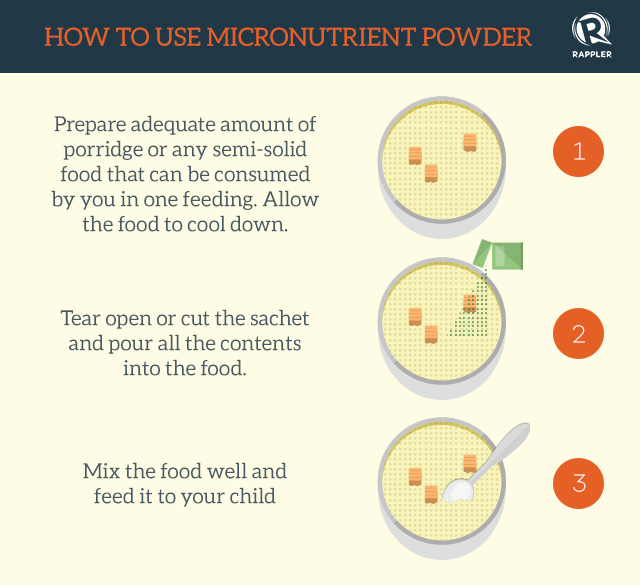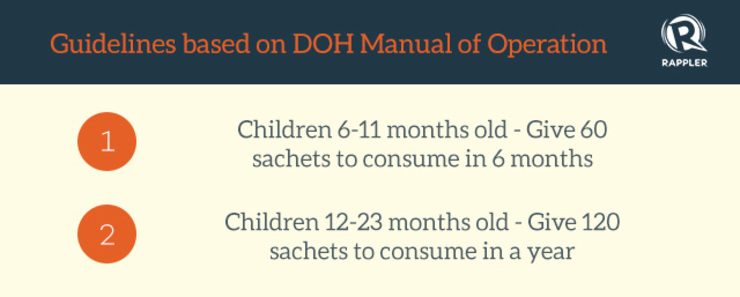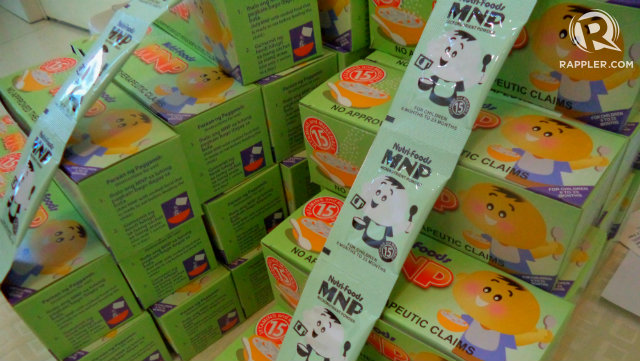SUMMARY
This is AI generated summarization, which may have errors. For context, always refer to the full article.
MANILA, Philippines – It is quite common among Filipino households to see parents feeding their young children lugaw (porridge) almost on a daily basis, since it is affordable and easy to prepare.
“Most parents use too much salt and do not use other ingredients in their lugaw,” said Dr Mary Castro, executive director of the Nutrition Center of the Philippines (NCP).
They can get carbohydrates from lugaw, but they will lack vitamins and minerals, according to Castro. “It’s better if they can eat more iron-rich foods like fruits and vegetables.”
However, not all parents can afford or are fully aware of how to prepare diverse and nutritious meals.
To address this issue, NCP developed a supplement known as “micronutrient powder” (MNP) which can “improve the nutrient quality of complementary foods.”
MNP is used in over 40 countries worldwide. The Philippines, through the Department of Health (DOH), has been purchasing supplies abroad. Just last year, NCP came up with the country’s first locally-manufactured MNP.
The development of PNFC’s capacity to produce the MNP was supported by the Global Alliance for Improved Nutrition (GAIN). The MNP produced is in line with both WHO and DOH guidelines
DOH currently acquires it supplies from NCP and distributes it nationwide. However, DOH’s coverage is still limited, according to Eusebeia Mendoza, NCP program officer.
Micronutrient deficiency – the lack of vitamins and minerals – is a form of malnutrition. It can lead to health complications such as anemia, impaired physical and cognitive development, and even death.
Micronutrient powder

Source: Nutrition Center of the Philippines
MNP is mixed with meals only after the porridge or any semi-solid food is cooked, and not while it is being cooked. It is for infants aged 6-23 months, following guidelines set by both WHO and DOH.
Once food is mixed with MNP, it can provide infants with their daily micronutrient needs regardless of the amount of food they eat.
MNP comes in sachets and does not require special preparation. It also does not affect the food’s flavor; hence children can easily consume it without noticing.

Studies have shown, according to NCP, that MNP can:
- Increase appetite
- Improve hemoglobin and vitamin A status
- Improve motor development and make children more active
During emergencies, children aged 6-59 months may be given one sachet of MNP each day until their access to proper food is restored.
“We need to promote interventions to address nutritional needs for emergency preparedness, response, and recovery. We can start by increasing public awareness on how to prevent malnutrition and the worsening of nutritional status,” Hygeia Gawe of the National Nutrition Council said.
MNP can be one of those interventions that can help children, especially in times of disaster.
LGUs
Some local government units (LGUs) have begun ordering supplies from NCP such as Pasig, Pasay, Cavite, and Laguna, according to Paul Hipolito of NCP.
Unfortunately, not all LGUs are aware of MNPs or the importance of micronutrients. Some LGUs also do not allot much funding for their health and nutrition programs. (READ: Hunger and bad governance)
“In the past 6 months, we’ve been visiting regions to introduce MNP,” Hipolito said.
As of now, only LGUs and NGOs can directly order MNPs for P2/sachet from NCP. “We don’t want to sell it yet to individuals because our goal is not to make money, but as a social enterprise, what we do is to help improve the lives of people,” Hipolito explained.
Hipolito estimated that children aged 6 months to 2 years covered by supplementary feeding programs usually make up around 4% of an area’s population. “Since DOH cannot cover all of this, we recommend LGUs to cover the remainder,” he added. (WATCH: Help kids reach their 5th birthday)
For individuals who want to donate MNPs to schools, Hipolito advises them to coordinate with their respective LGUs or NGOs of their choice who can then order supplies from NCP.
In the future, there are plans of expanding the MNP distribution, even among retail stores. – Rappler.com
For more information on Micronutrient Powder or to place orders, you may contact the Nutrition Center of the Philippines at 889-0329/843-8211 or askncp@ncp.org.ph.
How can we help fight hunger? Share your creative solutions with us. Send your stories, ideas, research and video materials to move.ph@rappler.com. Be part of the #HungerProject.
Add a comment
How does this make you feel?

There are no comments yet. Add your comment to start the conversation.